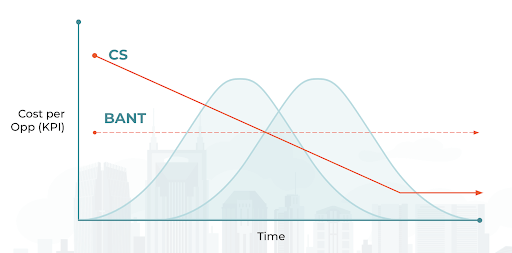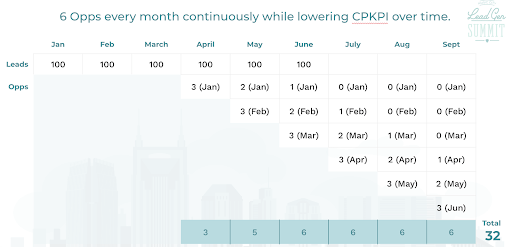Content syndication and other TOFU leads are like a house: given care and maintenance — nurturing — these leads will appreciate over their lifetime. On the other hand, BANT leads are locked in. They’re a fixed asset where you get out of them a standard amount over the lifetime of the lead, which is often shorter than other leads.
Let’s look at why this is.
Funnel stage affects your ability to nurture and build intent models

This image gives you a life of a lead over the course of the lead’s lifetime or an entire program’s lifetime. The movement from left to right along this curve shows the lead moving closer to purchase or down the funnel. Consider the peak of the curve as your in-market opportunity.
You’ll purchase content syndication leads in the left-hand part of the curve: where they’re in the beginning of their buying cycle. That means that you have those individuals in your Rolodex prior to them moving in-market.
On the other hand, when you purchase a BANT program, you’re buying access to leads who are at the peak of their in-market opportunity. These leads will make a decision and move on pretty quickly. The speed of the lead’s decision — and your limited access to the lead prior to the decision phase — means that you have very limited time to influence and nurture that purchase decision or build intent models based on the lead’s behavior.
Funnel stage affects cost per opportunity

This version of the chart shows two lead lifetimes or two separate programs that peak in-market at different times.
While the cost per opportunity or cost per KPI (CPKPI) for your BANT leads stays the same across both of these programs, the CPKPI for your content syndication (CS) leads will go down as you nurture more of those leads in-market.
With BANT leads, you purchase those leads while they’re in-market, and you have two options: close or lose them. These leads are one-time use and have a very limited lifespan, because they’ll make a purchase decision relatively quickly.
On the other hand, content syndication and other TOFU leads will show a decrease in CPKPI over time as you improve your nurture cycle, gather intent data, and move those leads in-market.
This is why you need to read your programs as a portfolio and look at their relative costs and pipeline over an extended period.
In the first couple of months of comparing BANT and content syndication leads, your BANT leads will likely have a lower cost per conversion, because those leads are already in-market. But as your content syndication leads move in-market, and you build your pipeline, you’ll see the CPKPI for the content syndication leads decrease while your BANT lead CPKPI will stay consistent.
Create a consistent, scalable pipeline
Let’s look at how this translates into creating a pipeline.
BANT leads create a consistent number of opportunities every month, and depending on your sales cycle, you can pretty easily predict how many conversions you’ll create every month. Lots of lead generation managers are seduced by this consistency, but because of the scarcity of leads in-market at any given time, purchasing BANT leads only scales to the limits of the market.
Content syndication leads provide greater range for scale, and they can also drive more opportunities over the lifetime of the lead than BANT leads. This image shows how three sets of CS leads, purchased in Q1 of this example year, might fare. While the leads don’t start converting until April, by June the number of opportunities peaks at twice the rate of a BANT program.

In this example, BANT leads will consistently convert every month, but CS leads will build up to a peak. Continuing to purchase those CS leads means that you can continue to nurture leads, lining up those peaks back to back each month.
The result of running long-term content syndication lead programs is a consistent pipeline of opportunities, where the CPKPI decreases consistently, and the total number of opportunities increases well past the total opportunities provided by a BANT program.

Do the math to really understand the long-term effect on your pipeline
Every company, program, and sales cycle is different, but the payoffs for purchasing leads before they move in-market is clear. With content syndication leads and other TOFU programs, you control your nurture campaigns and your sales outreach cadences, which has an effect on the overall conversion rate. With BANT leads, you trade some of that control for a speedy decision.
Whether you choose to purchase programs at the top or bottom of the funnel, TechnologyAdvice provides dedicated 1:1 support for your leads. Let’s talk.